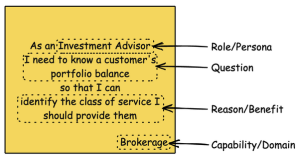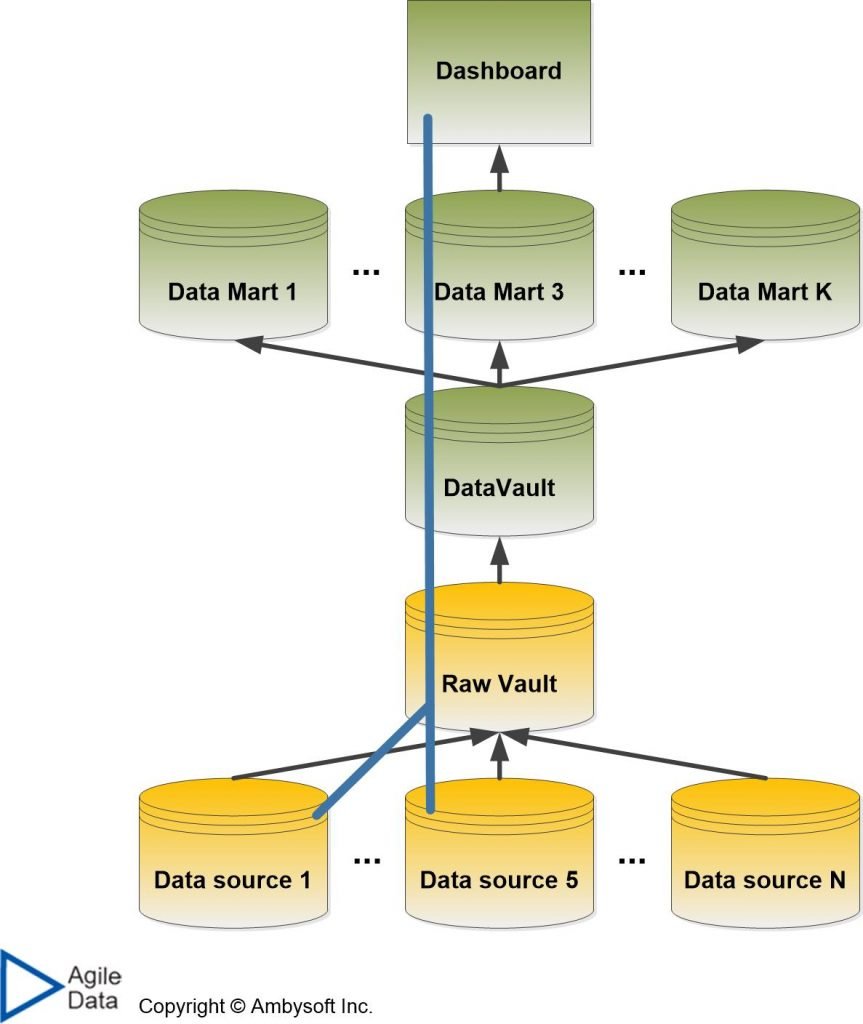Implementing Question Stories: User Stories for Data Teams
A question story is a specialized user story specific to data-oriented requirements. Question stories represent thin slices of value that are deployable into production. This article addresses the following topics:
- What are question stories?
- Implementing a question story on an agile/Scrum team
- Implementing a question story on a continuous delivery team
- The implementation activities
- What technical work needs to occur?
1. What Are Question Stories?
The following is an example of a question story (click on it to enlarge):
2. Implementing a Question Story on an Agile/Scrum Team
Let’s consider the case when a team is following a Scrum lifecycle. Figure 1 overviews an agile project lifecycle, although it is possible for this lifecycle to evolve into more of a continuous delivery lifecycle, where sprint 0 disappears because it occurred in the distant past, and the deploy phase disappears as a result of automation. Either way, the following advice still pertains.
Figure 1. The Agile Project Lifecycle (click to enlarge).

Figure 2 depicts the look-ahead data analysis work required for three question stories that are to be implemented during sprint #9 of an agile DW/BI initiative. Notice how each question story requires a different amount of data analysis effort due to the fact that every question has unique data needs.
Figure 2. Look-ahead data analysis on an agile team. Click to enlarge.

Figure 3 depicts the overall development effort for a single question story, including both the look-ahead analysis required for the data analytics as well as the implementation portion called out in Figure 2.
Figure 4. Implementing a question story on a Scrum team (click to enlarge).

3. Implementing a Question Story on a Continuous Delivery Team
Now let’s consider the situation when a team is following a continuous delivery lifecycle.
Figure 4. A Lean Continuous Delivery Lifecycle (click to enlarge).

Figure 5 depicts the look-ahead data analysis work for the same three question stories from Figure 2, the difference being that the work is done on a just-in-time (JIT) basis rather than scheduled into fixed-length sprints. Note that the same amount of data analysis is still required for each user story as in Figure 3, but that the implementation time is no longer tied to a two-week sprint.
Figure 5. Look-ahead data analysis on a continuous delivery team. Click to enlarge.

Figure 6 depicts the overall development effort for a single question story, including both the look-ahead analysis as well as the implementation portion called out in Figure 5.
Figure 6. Implementing a question story on a continuous delivery team (click to enlarge).

4. The Implementation Activities
As you saw in Figure 3 and Figure 5 there are several activities that the two flows have in common:
- Data analytics – Explore question.
- Data analytics – Explore data source(s).
- Data analytics – Build answer prototype.
- Data analytics – Validate answer.
- Specify answer (Agile/Scrum only).
- Review specification (Agile/Scrum only). Against DoR.
- Implement answer. See the detailed answer in the following section.
- Deploy answer. On a Scrum team you are likely to batch up several answer implementations, whereas on a CD team you hopefully deploy once the answer is ready to be released.
5. What Technical Work Needs to Occur?
Figure 7 depicts how a question story can be implemented as a thin slice. The green boxes represent major components of a DataVault 2 approach to architecting a DW/BI solution and the blue line indicates the vertical slice that implements the given question story. In this case, new data elements from two sources, Data Source 1 and Data Source 5, are used. The new data elements from these two data sources are loaded into a raw vault, then into the data vault, into Data Mart 3, where it is then displayed on a dashboard. Other data that already existed in the raw vault and upwards was also used to implement the question story.
Figure 7. Implementing a question story as a thin slice (click to enlarge).
The implied technical work to implement this question story includes:
- Data analysis of the two data sources. This requires the data analytics activities mentioned above.
- Extract and load data from the two sources.
- Update of extract, transform, and load (ETL) from the raw vault to the data vault.
- Update of the ETL from the data vault to Data Mart 3.
- Update the dashboard to display the information.
5. Related Resources
- Agile Analytics
- Agile Data Warehousing: A Disciplined Approach
- AI Stories: Extending User Stories for AI Development
- Implementing a Question Story in Data Vault 2: White Paper
- Look-Ahead Data Analysis
- Question Stories: Extending User Stories for Data
- User Stories: An Agile Introduction
Recommended Reading

This book, Choose Your WoW! A Disciplined Agile Approach to Optimizing Your Way of Working (WoW) – Second Edition, is an indispensable guide for agile coaches and practitioners. It overviews key aspects of the Disciplined Agile® (DA™) tool kit. Hundreds of organizations around the world have already benefited from DA, which is the only comprehensive tool kit available for guidance on building high-performance agile teams and optimizing your WoW. As a hybrid of the leading agile, lean, and traditional approaches, DA provides hundreds of strategies to help you make better decisions within your agile teams, balancing self-organization with the realities and constraints of your unique enterprise context.
I also maintain an agile database books page which overviews many books you will find interesting.


